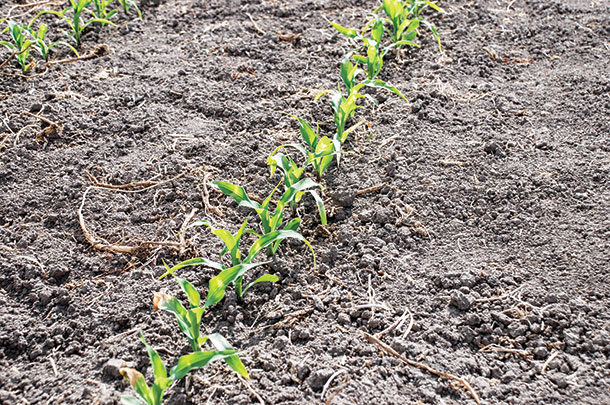Terminating the stand and spending some time in another crop allows a grower to press the reset button on a piece of ground, allowing a more productive return to alfalfa several years later.
The current low-price environment for crops, however, has many growers debating whether to rotate that declining alfalfa stand or hang on to it for another year. Corn is a common rotation partner with alfalfa in many parts of the U.S. Although it is difficult for another crop to match the ability of corn to produce high yields, the cost of production for corn can also be high.
Over the past five years, we have conducted over 30 research trials at Utah State University (USU) on alfalfa-to-corn rotations. The goal of this work has been to identify management strategies to improve profitability of rotation from alfalfa to corn in a low price year. Key observations from that work are summarized below.
Tillage
Tillage has historically been the staple method for terminating alfalfa. The large farms of today, coupled with high costs of fuel and equipment and concern about soil health, have heightened interest in reducing the amount of tillage for alfalfa stand removal.
Any tillage pass that can be eliminated offers the benefits of improved soil quality (improved soil moisture retention, improved soil structure, greater nutrient cycling and increased soil organic matter) and increased economic profitability (reduced labor, equipment costs and fuel).
The most extreme case of reduced tillage is no-till. In no-till, corn is seeded directly into the old alfalfa stand. Although widely utilized in many parts of the U.S., very few alfalfa growers in the West employ no-till, perhaps due to the perception that after years of wheel traffic from heavy equipment, alfalfa fields are so compact as to more closely resemble a paved roadway than a seedbed.
In research conducted at USU in multiple commercial production fields across Utah, an average yield loss of 9 percent was measured by direct seeding into alfalfa compared to conventional tillage. In the current low price environment for corn, such a yield loss may be acceptable considering the time and expense that would be saved by not tilling.

When direct seeding corn into alfalfa, planting the seed at the correct depth (at least 1.5 inches) is critical. In the dry conditions of the West, fields usually require pre-irrigation to moisten the soil in the days prior to planting to allow the disc openers to penetrate the soil.
A variation on no-till is strip-till. In strip-till, a small strip (usually 7 to 8 inches) is tilled, while the remaining space between rows remains no-till. Corn is planted directly into the tilled strip. The benefits of strip-till are that it requires only one tillage pass, allows planting into a tilled seedbed and keeps residue on the soil between rows to conserve moisture and suppress weeds – often billed as a cross between conventional tillage and no-till.
USU research conducted at multiple sites and years has shown yield reductions of about 7 percent in strip-till compared to conventional tillage.
Timing of tillage to terminate a declining alfalfa stand for optimal corn yield has been the subject of much debate by many growers. Our work at USU over multiple locations and years has shown no measurable difference in silage corn yield whether the alfalfa stand was terminated by tillage in the fall or spring. This suggests that tillage can simply be done when time allows.
Herbicides
A grower interested in cost savings may be tempted to eliminate the herbicide application used to kill alfalfa. With reduced-tillage corn production approaches, the likelihood of regrowth from the old alfalfa stand increases. Since alfalfa fixes nitrogen, there may be a perception that alfalfa growing in corn isn’t doing harm.
This is not true. While it may be surprising to some producers, research conducted at USU over multiple sites and years, found that volunteer alfalfa in conventionally tilled corn reduced corn yield greater than 25 percent compared to herbicide treatments which effectively terminated alfalfa prior to planting corn. Even if alfalfa was killed with post-emergence treatments after corn emergence, corn yields were reduced.
The increased corn yields from effective alfalfa termination easily justify extra herbicide costs. Herbicide options for removing a conventional alfalfa stand include glyphosate alone plus tillage or combination of glyphosate plus 2,4-D or dicamba.
However, chemical removal of Roundup Ready varieties generally is accomplished with 2,4-D combined with dicamba. When using either 2,4-D or dicamba, plant-back restrictions must be observed to prevent carryover injury to the subsequent corn crop.
Termination of conventional alfalfa varieties can also conveniently be accomplished by applying glyphosate three days prior to harvest, eliminating alfalfa regrowth following harvest. Growth regulator herbicides cannot be applied pre-harvest, requiring a minimum of 6 inches of regrowth after harvest, effectively delaying tillage or planting operations.
Double crop
Some growers have begun to double-crop alfalfa and corn to improve the economics of crop rotation. The idea is to take the first cutting of alfalfa and then follow immediately behind with corn. The first cutting of alfalfa usually has the highest yield.
The alfalfa is also already in place, so there is very little cost of production other than the cost to harvest. Although some corn yield is often sacrificed in double-cropping systems due to shortened corn production period, many earlier- maturing hybrids can produce yields that are not much below full-season hybrids.

To speed the transition between crops, chopping (rather than baling) the first-cut alfalfa can trim a week or more off the time required to put up dry hay. Reduced tillage practices such as no-till and strip-till can also reduce the time required to prepare the seedbed and can expedite the corn planting process. In conventional alfalfa, the pre-harvest glyphosate approach can reduce time required between alfalfa termination and corn planting.
N fertilizer
Nitrogen (N) is critical to the proper growth and development of corn and generally has a greater impact on corn yield than any other nutrient. Some of the N needs of corn are met by the breakdown of organic matter and previous crop residues in the soil, but the balance comes from N fertilizer application. Nitrogen fertilizer generally represents the highest cost input in corn production.
Most Utah growers target an N rate of approximately 200 to 250 units per acre, often allowing for an N credit of 50 to 100 units per acre to reduce the amount of N applied following an alfalfa crop. To test the validity of this standard N credit, we applied four rates of N fertilizer (0, 50, 100 and 200 pounds N/acre) to first-year corn grown after alfalfa in farmers’ fields throughout Utah.

While there was a fair amount of variability between sites, there was no statistical difference in yield at any of the sites over the rates of N application studied. This strongly suggests that growers are able to reduce N fertilizer application much more than the traditional 50-units- per-acre credit, or perhaps even eliminate it altogether.
The primary reason for the lack of response to N following alfalfa is due to high residual N in the soil that becomes available to the corn crop over the season.
Table 1 shows selected soil analysis from three of the study sites indicating high levels of residual nitrate N, which is immediately available to the corn crop, and even higher labile N in organic forms (estimated by total N minus nitrate N) that can become available to the crop as the organic matter is broken down over the course of the season.

Residual organic forms of N may continue to provide N to corn or other crops grown at a given site even beyond the first year following alfalfa.
It should be noted that care was taken to make sure other important nutrients, particularly phosphorus (P) and potassium (K) were at satisfactory levels for the study described. Intensively hayed fields over the life of an alfalfa stand can become depleted of these important nutrients critical to root growth and energy storage and transfer (role of P) and good water relations (role of K) in corn or any other rotational crop.
Soil tests should be taken and appropriate recommendations for these important nutrient elements should be followed to ensure all nutritional needs of rotational crops are sufficiently met. ![]()
Earl Creech is an assistant professor and extension agronomist with Utah State University. Email Earl Creech.
Grant Cardon is an extension soils specialist; Corey Ransom is an extension weed specialist, both with Utah State University.
PHOTO 1: Conventional-till corn planted after alfalfa.
PHOTO 2: No-till corn planted after alfalfa.
PHOTO 3: Strip-till corn planted after alfalfa.
PHOTO 4: Alfalfa regrowth in corn after conventional tillage. An infestation at this level will result in a yield loss of over 25 percent by the end of the season if not controlled. Photos by Earl Creech.










